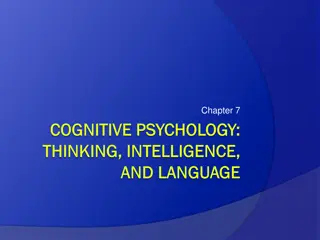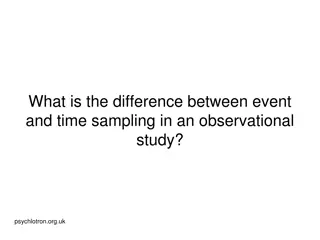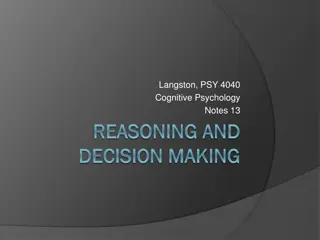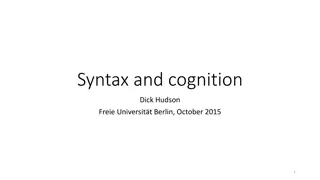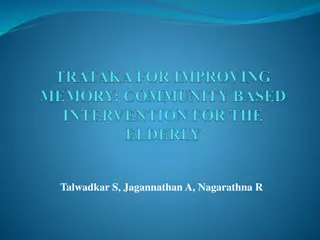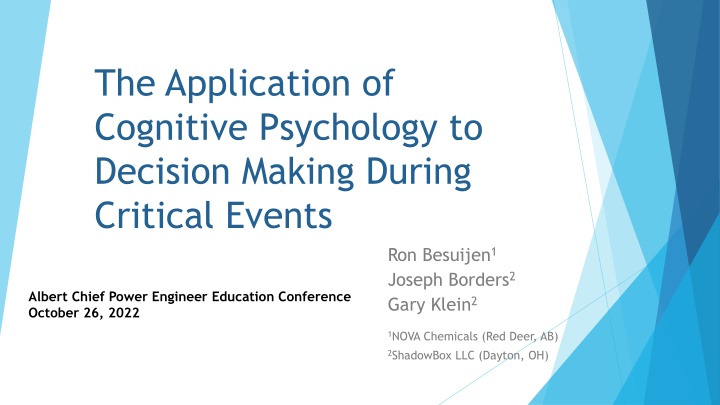
Enhancing Decision Making in Critical Events with Cognitive Psychology
Explore the application of cognitive psychology in decision-making during critical events, emphasizing the importance of procedures, knowledge types, and the limitations of automated systems. Learn how strengths and weaknesses of procedures can impact operational safety and reliability.
Download Presentation

Please find below an Image/Link to download the presentation.
The content on the website is provided AS IS for your information and personal use only. It may not be sold, licensed, or shared on other websites without obtaining consent from the author. If you encounter any issues during the download, it is possible that the publisher has removed the file from their server.
You are allowed to download the files provided on this website for personal or commercial use, subject to the condition that they are used lawfully. All files are the property of their respective owners.
The content on the website is provided AS IS for your information and personal use only. It may not be sold, licensed, or shared on other websites without obtaining consent from the author.
E N D
Presentation Transcript
The Application of Cognitive Psychology to Decision Making During Critical Events Ron Besuijen1 Joseph Borders2 Gary Klein2 Albert Chief Power Engineer Education Conference October 26, 2022 1NOVA Chemicals (Red Deer, AB) 2ShadowBox LLC (Dayton, OH)
Case Study Turbo Overspeed Procedures and automation are critical tools for safe & reliable operation There are instances where events cannot be anticipated, and operations must intervene In this example the automation failed and there was no procedure
SDV & FC closed 30 sec. after trip Hydrogen Flow increased 74% Operator closed valve Valve in manual at 70% Pressure dropped 250 Kpa Drum carried over SDV SDV FC FC Condensor PC PC Refrigerant Expander Expander 50% Feed Reduction Reflux Drum Compressor SDV failed to close Compressor Chilling Train Exchangers PC PC SDV SDV Chilling Train liquids Reflux Pump PC Drum carried over Chilling Train vapour Suction Drum High Methane Stripper Level Trip Suction Drum DeMethanizer Reboiler DeEthanizer Knockout Pump
Types of Knowledge Explicit knowledge Declarative information Procedures & manuals Readily accessed and verbalized Tacit Knowledge Pattern recognition Rooted in experience, practice and values Making connections Mental Models Hard to communicate
Strengths of Procedures They are training tools for novices. They are memory aids. They can safeguard against interruptions. They reduce workload. They compile experience and historical information. They help teams coordinate by imposing consistency.
Procedures Arent Sufficient: The boundary conditions for procedures Procedures are advisable for well-ordered situations They become brittle in complex situations They may be insensitive to context, and can mislead us The steps can overlap They rarely apply to anomalies Impossible to proceduralize all possibilities
Automated Systems Increase Safety & Efficiency but also add Complexity Automated systems can improve safety and efficiency via: Responsiveness, Repeatability, Reliability However, automation takes the decision making away from the operator (i.e., out of the loop) What happens when equipment (e.g., sensors, equipment, automation) fails? Managing the failure requires troubleshooting by skilled operators These systems are more challenging to prepare for every possibility Operators need a mental model of the system AND of the automated decision support (which are sometimes opaque and difficult to understand)
Mental Models Internally generated models of the world (e.g., systems) Allow us to describe, explain, reason, and predict Rich and accurate mental models lead to better performance Capabilities Limitations How the system works: How the system fails: System Parts, connections, causal relationships, process control logic Common breakdowns and limitations (e.g., boundary conditions) How to make the system work: How users get confused: User Detecting anomalies, appreciating the system s responsiveness, performing workarounds and adaptations The kinds of errors people are likely to make
Challenge Can you think of a time when automation introduced additional challenges for a decision maker during a critical event?
Developing Cognitive Skills & Accelerating Expertise Training objectives Augmenting on-the-job experiences with feedback and training exercises Presenting a wide range of situations increasing reps Promoting discovery and restructuring inadequate mental models Scenario-based training - Trainee must recognize problem as well as provide a solution Decision Making Exercises (DMX) ShadowBox training Simulation approaches
Decision Making Exercises (DMX) Adapted from Tactical Decision Games Requires a facilitator/trainer Group or one-to-one sessions Presents a dynamic scenario using graphics/maps Requires participants to assess the situation and make decisions (i.e., what will you do and why?) Facilitator leads discussion to analyze assessments and decisions Unpacking trainee s mental models to identify flaws and limitations Providing coaching to consider the optimal response(s), and emphasizing the why behind actions
ShadowBox Training Problem: Skilled facilitators are costly and often unavailable Need to develop cognitive skills into training ShadowBox approach: Complex scenarios Requires assessment, decision-making, and providing rationale Rationale: Shadow the Subject-Matter Experts (SMEs) Enable trainees to see the world through the eyes of the experts Appreciate the mental models of experts No SMEs must be present
ShadowBox Example ShadowBox Example Decision Point 1 Decision Point 1 Select the top three variables that you would monitor to Select the top three variables that you would monitor to ensure stable Stripper Tower operation. ensure stable Stripper Tower operation. Level of the tower Level of the tower Feed to the tower Feed to the tower Flow out of the tower Flow out of the tower Tower delta pressure Tower delta pressure dP dP Steam flow out the vent Steam flow out the vent Temperature on tower vent Temperature on tower vent
ShadowBox Example ShadowBox Example Decision Point 2 Decision Point 2 What is your assessment of the situation? What is your assessment of the situation? FV202 is malfunctioning FV202 is malfunctioning LC201 transmitter is reading high LC201 transmitter is reading high FC202 failed close FC202 failed close FC202 transmitter failed FC202 transmitter failed Tower feed increased Tower feed increased
ShadowBox Example ShadowBox Example Decision Point 3 Decision Point 3 What are the most important actions to take at this What are the most important actions to take at this moment? moment? Reduce FC202 output Reduce FC202 output Have Field operator check FV202 output Have Field operator check FV202 output Reduce feed to the tower Reduce feed to the tower Increase FC202 output to 100% Increase FC202 output to 100% Shut down pump Shut down pump Increase tower steam flow Increase tower steam flow
Summary Procedures and automation are critical tools for safe & reliable operation Cognitive skills are required to allow operators the ability to manage the situations that have not been anticipated Training exercises can be developed to enhance cognitive skill development
Questions Please send follow up questions and thoughts to: ron.besuijen@novachem.com








